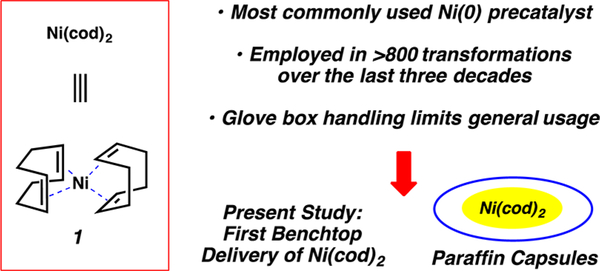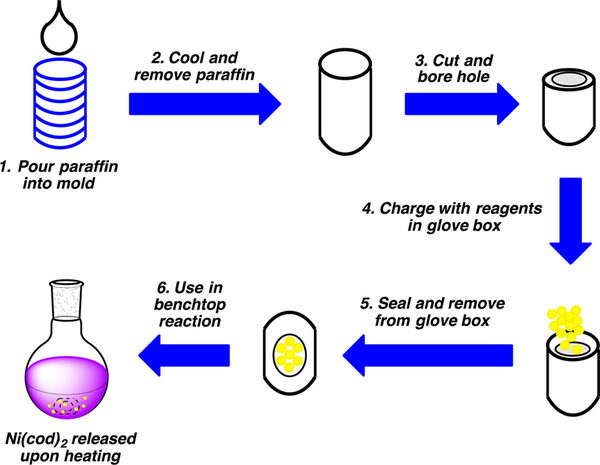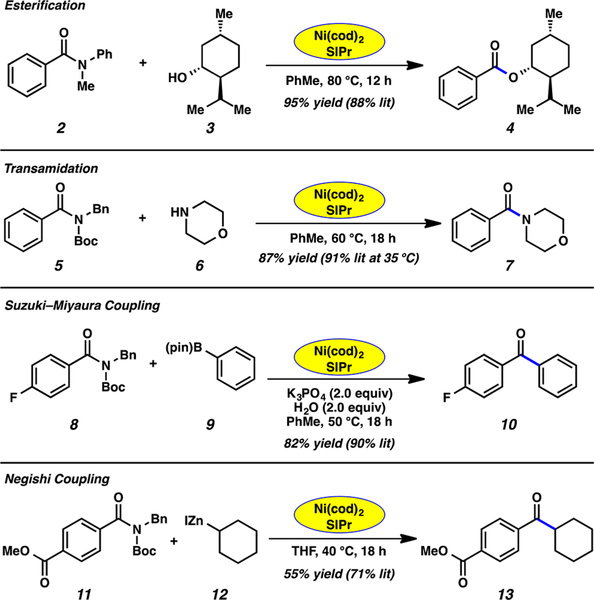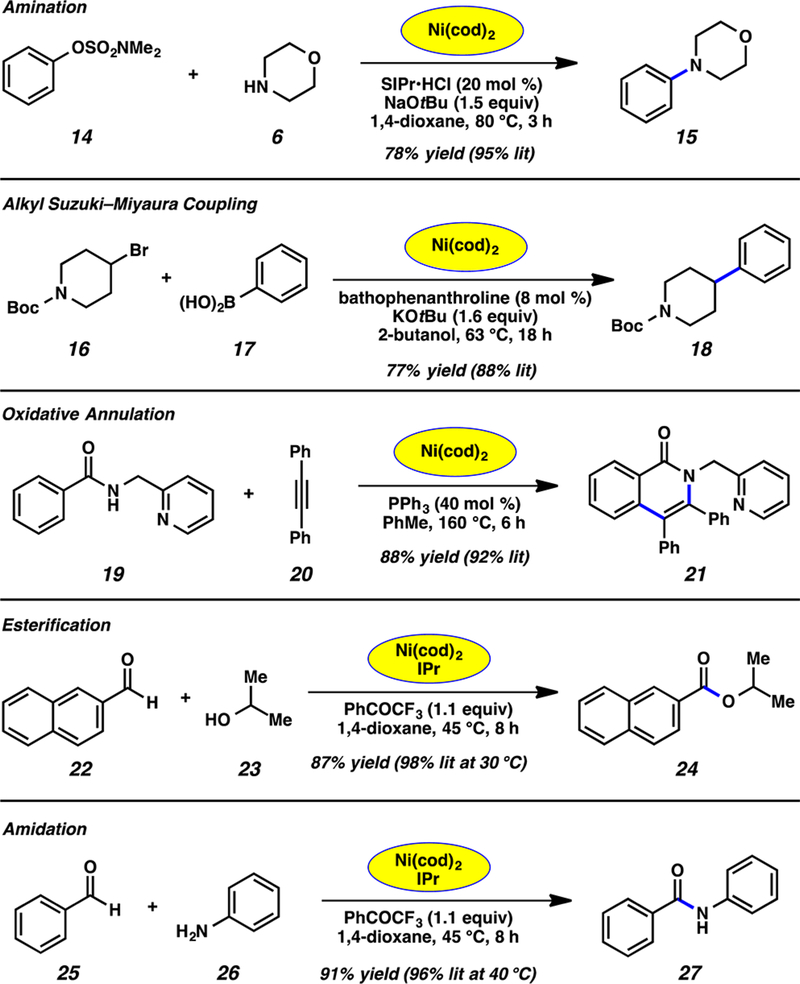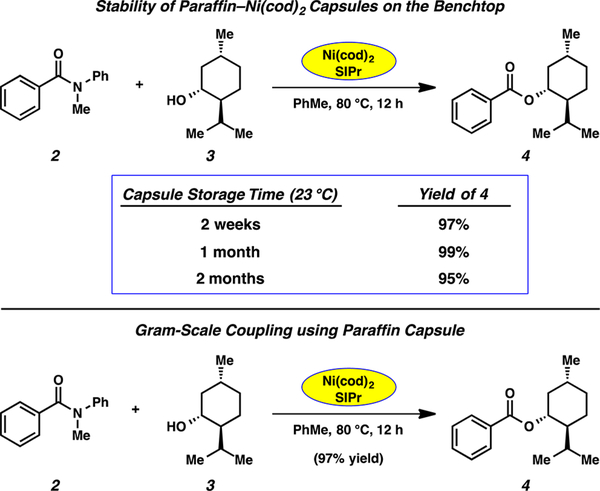Abstract
A facile method that allows for Ni(cod)2 to be used on the benchtop is reported. The procedure involves the preparation of paraffin— Ni(cod)2 capsules, which are stable to air and moisture. It is demonstrated that these readily available capsules can be used to promote a range of Ni(cod)2-catalyzed transformations. These studies are expected to promote the further use of Ni(cod)2 in organic synthesis.
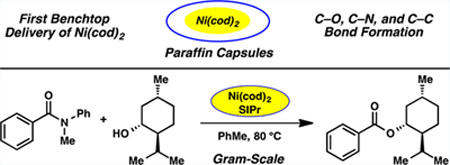
In recent years, there has been an outpouring of new methodologies that involve the use of nonprecious metal catalysts.1 Nickel-catalyzed reactions, in particular, have grown increasingly popular because of nickel’s high natural abundance, low cost, and low CO2 footprint.1 Moreover, the unique reactivity of nickel has opened new doors with regard to fundamental transformations.
A key challenge in the realm of nickel catalysis is the limited availability of Ni(0) precatalysts.2 The most commonly used Ni(0) precatalyst is bis(1,5-cyclooctadiene)nickel(0) or Ni(cod)2 (1, Figure 1), which has been employed in greater than 800 synthetic studies over the past three decades.1,3 The cyclooctadiene ligands can be readily displaced by other ligands in situ, providing a means to examine and utilize various Ni/ligand combinations to enable a given reaction. However, Ni(cod)2 is not air-stable and requires handling in an inert atmosphere. Accordingly, the widespread use of Ni(cod)2-promoted methodologies in chemical synthesis has remained limited.
Figure 1.
Ni(cod)2 (1) and benchtop delivery using paraffin capsules (present study).
One clever strategy for handling air sensitive catalysts is to prepare paraffin-based formulations. Inspired by the success of this approach in a recent seminal study by Buchwald,4 we sought to prepare paraffin–Ni(cod)2 capsules.5 Herein, we report the preparation of these capsules and demonstrate that they can be used to perform a host of Ni(cod)2-catalyzed reactions on the benchtop.
The capsules were prepared using the method summarized in Figure 2. Melted paraffin wax (mp 53–57 °C) was placed into a standard brass mold. After cooling, the resulting wax cylinder was removed from the mold and trimmed to the desired size. Next, a cavity was bored in the wax cylinder using a standard drill bit. The resulting hollow and open capsule was brought into a glove box and charged with Ni(cod)2. For some capsules, the air-sensitive NHC ligands SIPr or IPr were also added. After charging the capsules, a warm metal spatula was used to melt the top of the capsule closed. Removal from the glove box and redipping in molten wax (to ensure a proper seal) gave the desired capsules that were ready for use on the benchtop.6
Figure 2.
Preparation of paraffin−Ni(cod)2 capsules.
As our laboratory has recently developed several new Ni(cod)2-mediated reactions involving amide derivatives,7 we were eager to test the paraffin–Ni(cod)2 capsules in these processes. Figure 3 shows the success of these efforts. Initially, we sought to perform the esterification of amides.7a We were delighted to find that benchtop delivery of Ni(cod)2 facilitated the reaction of anilide 2 with (–)-menthol (3) to provide ester 4 in 95% yield. Having validated the feasibility of this approach, we examined several other reactions of amides. Transamidation of Boc-activated secondary amide 5 with morpholine (6) provided amide 7 in 87% yield.7d C–C bond formation from amides could also be achieved. For example, Suzuki–Miyaura cross-coupling of Boc-activated amide 8 with boronate 9 generated benzophenone 10 in 82% yield.7b Finally, Negishi coupling of amide 11 with organozinc halide 12 produced ketone 13, albeit in slightly diminished yield.7c
Figure 3.
Ni-catalyzed reactions of amides using paraffin−Ni(cod)2 capsules. 5−10% Ni(cod)2 and 5−10% SIPr were employed (see Supporting Information for details). The yields shown reflect the average of two isolation experiments.
Having validated the utility of the paraffin–Ni(cod)2 capsules in the context of amide activation reactions, we tested the capsules in several other nickel-catalyzed processes (Figure 4). Buchwald–Hartwig coupling of sulfamate 14 with morpholine (6) furnished aniline derivative 15 using the benchtop variant of previously reported conditions.8 Additionally, we tested the air-stable variant of Ni(cod)2 in the context of the sp2–sp3 Suzuki–Miyaura cross-coupling.9 Thus, alkyl bromide 16 was coupled with phenylboronic acid (17) to afford arylated piperidine 18.2b Another attractive use of Ni(cod)2 lies in oxidative C–H functionalization reactions,10,11 so we were keen to test the utility of our paraffin capsules in these methods as well. Under conditions developed by Chatani,10 amide 19 underwent N-directed oxidative annulation with diphenylacetylene (20) to furnish isoquinolinone 21 in 88% yield. Finally, two oxidative conversions of aldehydes were tested. Oxidative esterification of aldehyde 22 with isopropanol (23) using Dong’s recent methodology gave rise to ester 24 in excellent yield.11 Moreover, oxidative amidation of benzaldehyde (25) with aniline (26) using paraffin-encapsulated Ni(cod)2/IPr delivered amide 27.11 Of note, the paraffin–Ni(cod)2 capsules can be employed in a variety of solvents (e.g., 1,4-dioxane, THF, 2-butanol, toluene), as long as the reaction mixture is heated to 40 °C or higher.
Figure 4.
Ni-catalyzed amination, alkyl Suzuki–Miyaura coupling, oxidative annulation, esterification, and amidation using paraffin–Ni(cod)2 capsules. 4–10% Ni(cod)2 and 5–5.5% IPr was employed (see Supporting Information for details). The yields shown reflect the average of two isolation experiments.
The paraffin–Ni(cod)2 capsules were further evaluated via the experiments shown in Figure 5. In order to gauge the air stability of our paraffin–Ni(cod)2 capsules, the esterification of amide 2 with (–)-menthol (3) was carried out with capsules that had been stored on the benchtop for 2 weeks, one month, and two months. In all cases, the desired ester product 4 was obtained in >95% yield, indicating that prolonged exposure to atmospheric oxygen and water does not reduce the efficacy of the encapsulated Ni precatalyst.12,13 We also performed a gram-scale coupling. To our delight, the benchtop esterification using one gram of substrate 2 delivered menthol ester 4 in 97% yield.
Figure 5.
Stability tests of paraffin–Ni(cod)2 capsules and gram-scale coupling. The yields for the stability test experiments were determined by 1H NMR analysis using 1,3,5-trimethoxybenzene as an external standard. The yield for the gram-scale coupling reflects the yield of isolated product.
We have developed a facile approach that allows for Ni(cod)2 to be used on the benchtop. Our strategy involves the preparation of paraffin–Ni(cod)2 capsules, which are stable to air and moisture. The capsules, which will soon be commercially available,14 promote a range of Ni(cod)2-catalyzed transformations, including reactions of amides, aminations, alkyl Suzuki–Miyaura couplings, oxidative annulations, esterifications, and amidations. We hope that the method disclosed herein will help nurture the burgeoning field of nickel catalysis in academia and industry.
Supplementary Material
ACKNOWLEDGMENTS
The authors are grateful to Boehringer Ingelheim, Bristol-Myers Squibb, the Camille and Henry Dreyfus Foundation, the University of California, Los Angeles, the NSF (N.A.W., DGE-1144087), the Foote Family (N.A.W. and J.E.D.), and the UCLA Gold Shield Alumnae for financial support. These studies were supported by shared instrumentation grants from the NSF (CHE-1048804) and the NIH NCRR (S10RR025631).
Footnotes
ASSOCIATED CONTENT
Supporting Information
The Supporting Information is available free of charge on the ACS Publications website at DOI: 10.1021/acs.orglett.6b01758.
Experimental details and compound characterization data (PDF)
The authors declare no competing financial interest.
REFERENCES
- (1).(a) Rosen BM; Quasdorf KW; Wilson DA; Zhang N; Resmerita A-M; Garg NK; Percec V. Chem. Rev 2011, 111, 1346–1416. [DOI] [PMC free article] [PubMed] [Google Scholar]; (b) Tasker SZ; Standley EA; Jamison TF Nature 2014, 509, 299–309. [DOI] [PMC free article] [PubMed] [Google Scholar]; (c) Mesganaw T; Garg NK Org. ProcessRes. Dev 2013,17, 29–39. [Google Scholar]; (d) Ananikov VP ACS Catal. 2015, 5, 1964–1971. [Google Scholar]
- (2).An attractive workaround involves the use of air-stable Ni precatalysts. For select examples, see: [Google Scholar]; (a) Shields JD; Gray EE; Doyle AG Org. Lett. 2015,17, 2166–2169. [DOI] [PMC free article] [PubMed] [Google Scholar]; (b) Magano J; Monfette S ACS Catal. 2015, 5, 3120–3123. [Google Scholar]; (c) Standley EA; Jamison TF J. Am. Chem. Soc 2013,135,1585–1592. [DOI] [PMC free article] [PubMed] [Google Scholar]; (d) Park NH; Teverovskiy G; Buchwald SL Org. Lett. 2014, 16, 220–223. [DOI] [PMC free article] [PubMed] [Google Scholar]; (e) Ge S; Hartwig JF Angew. Chem., Int. Ed 2012, 51, 12837–12841. [DOI] [PMC free article] [PubMed] [Google Scholar]; (f) Leowanawat P; Zhang N; Safi M; Hoffman DJ; Fryberger MC; George A; Percec VJ Org. Chem. 2012, 77, 2885–2892. [DOI] [PubMed] [Google Scholar]; (g) Zhang N; Hoffman DJ; Gutsche N; Gupta J; Percec VJ Org. Chem. 2012, 77, 5956–5864. [DOI] [PubMed] [Google Scholar]; (h) Jezorek RL; Zhang N; Leowanawat P; Bunner MH; Gutsche N; Pesti AKR; Olsen JT; Percec V Org. Lett. 2014, 16, 6326–6329. [DOI] [PubMed] [Google Scholar]; (i) Malineni J; Jezorek RL; Zhang N; Percec V Synthesis 2016, DOI: 10.1055/s-0035-1562342. [DOI] [Google Scholar]; (j) Malineni J; Jezorek RL; Zhang N; Percec V Synthesis 2016, DOI: 10.1055/s-0035-1562343. [DOI] [Google Scholar]; (k) Leowanawat P; Zhang N; Resmerita A-M; Rosen BM; Percec VJ Org. Chem. 2011, 76, 9946–9955. [DOI] [PubMed] [Google Scholar]; (l) Leowanawat P; Zhang N; Percec VJ Org. Chem. 2012, 77, 1018–1025. [DOI] [PubMed] [Google Scholar]
- (3).SciFinder searching for bis(1,5-cyclooctadiene)nickel(0) being used as a reagent yielded hits corresponding to 848 original manuscripts since 1985. (accessed 28 April, 2016).
- (4).In a recent seminal study, Buchwald demonstrated that Pd/ligand combinations could be dosed into paraffin capsules; see: Sather AC; Lee HG; Colombe JR; Zhang A; Buchwald SL Nature 2015, 524, 208–211. [DOI] [PMC free article] [PubMed] [Google Scholar]
- (5).Paraffin has been used to impart stability to air and moisture sensitive reagents in a variety of contexts. For examples of paraffin- reagent dispersions, see: [Google Scholar]; (a) Taber DF; Li H-Y U.S. Patent 20050288257, Dec. 29, 2005. [Google Scholar]; (b) Fang Y; Liu Y; Ke Y; Guo C; Zhu N; Mi X; Ma Z; Hu Y Appl Catal., A 2002,235,33–38. [Google Scholar]; (c) Taber DF; Frankowski KJ J. Org. Chem. 2003, 68, 6047–6048. [DOI] [PubMed] [Google Scholar]; (d) Taber DF; Nelson CGJ Org. Chem. 2006, 71, 8973–8974. For examples of reagents encapsulated in paraffin, see: [DOI] [PMC free article] [PubMed] [Google Scholar]; (e) Kosak KM; Kosak MKUS Patent 5413924, May 9, 1995. [Google Scholar]; (f) Shen C; Spannenberg A; Wu X-F Angew. Chem., Int. Ed. 2016, 55, 5067–5070. [DOI] [PubMed] [Google Scholar]
- (6).Typically, the capsules used in Figures 3 and 4 contained 2–14 mg of Ni(cod)2, although it is estimated that these capsules could hold up to 35 mg of Ni(cod)2 Additionally, larger capsules can be prepared to hold greater amounts of Ni(cod)2 See the Supporting Information for details. At the conclusion of a reaction, the paraffin wax can be removed by dry-loading the reaction mixture on SiO2 and eluting with hexanes and CH2Cl2. See the Supporting Information for details.
- (7).(a) Hie L; Fine Nathel NF; Shah TK; Baker EL; Hong X; Yang Y-F; Liu P; Houk KN; Garg NK Nature 2015, 524, 79–83. [DOI] [PMC free article] [PubMed] [Google Scholar]; (b) Weires NA; Baker EL; Garg NK Nat. Chem. 2016, 8, 75–79. [DOI] [PubMed] [Google Scholar]; (c) Simmons BJ; Weires NA; Dander JE; Garg NK ACS Catal. 2016, 6, 3176–3179. [DOI] [PMC free article] [PubMed] [Google Scholar]; (d) Baker EL; Yamano MM; Zhou Y; Anthony SM; Garg NK Nat. Commun. 2016, 7, 11554. [DOI] [PMC free article] [PubMed] [Google Scholar]
- (8).Ramgren SD; Silberstein AL; Yang Y; Garg NK Angew. Chem., Int. Ed 2011, 50, 2171–2173. [DOI] [PMC free article] [PubMed] [Google Scholar]
- (9).Zhou J; Fu GC J. Am. Chem. Soc 2004, 126, 1340–1341. [DOI] [PubMed] [Google Scholar]
- (10).Shiota H; Ano Y; Aihara Y; Fukumoto Y; Chatani NJ Am. Chem. Soc 2011, 133, 14952–14955. [DOI] [PubMed] [Google Scholar]
- (11).Whittaker AM; Dong VM Angew. Chem., Int. Ed 2015, 54, 1312–1315. [DOI] [PMC free article] [PubMed] [Google Scholar]
- (12).The robustness of the paraffin–Ni(cod)2 capsules with regard to exposure to water was also tested. A capsule that had been submerged in water for 1 h and subsequently dried with a paper towel was found to promote the esterification of amide 2 with (–)-menthol (3) to give 4 in 94% yield.
- (13).The esterification of amide 2 with (–)-menthol (3) was also carried out using nonencapsulated Ni(cod)2 and SIPr that had been exposed to air. After only 1 h of air exposure, the attempted esterification led to the full recovery of starting material. See the Supporting Information for details.
- (14).Paraffin capsules containing Ni(cod)2 and Ni(cod/SIPr will soon be available commercially from TCI (TCIchemicals.com) and Sigma-Aldrich. The capsules and their TCI product numbers are as follows (Sigma-Aldrich product numbers are pending): Bis(1,5-cyclooctadiene)nickel(0) (Wax encapsulated): B5417. Bis(1,5-cyclo-octadiene)nickel(0)–1,3-Bis(2,6-diisopropylphenyl)imidazolidin-2-yli-dene (Wax encapsulated): B5418.
Associated Data
This section collects any data citations, data availability statements, or supplementary materials included in this article.



